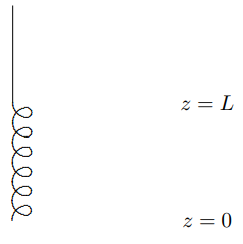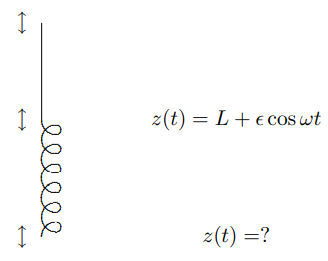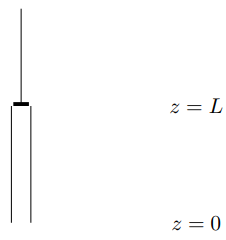7.4: Chapter Checklist
- Page ID
- 34387
Learning Objectives
You should now be able to:
- Find the motion of a point on a continuous spring oscillating longitudinally in one of its normal modes for various boundary conditions;
- Solve for the normal modes of a system of a mass attached to a massive spring;
- Be able to derive the dispersion relation for sound waves and find the normal modes for oscillations of air in a tube;
- Be able to use the Helmholtz approximation to estimate the frequency of the lowest mode of bottle.
Problems
7.1. Derive (7.45) directly by considering the volume of the chunk of air in the tube between \(z\) and \(z + dz\), and using (7.38).
7.2. Use an analogy with (7.16)-(7.31) to find (approximately!) the normal modes and corresponding frequencies of the system shown in Figure \( 6.1\), but with a massive ring of mass m sliding on the frictionless rod.

Figure \( 7.7\): A hanging spring.
7.3. A massive continuous spring with mass \(m\), length \(L\) and spring constant \(K\) hanging vertically. The system is shown at rest in its equilibrium configuration in Figure \( 7.7\). The spring constant is large, satisfying \(K L \gg m g\), so gravity plays no important role here except to keep the spring vertical. Now suppose that the supporting hanger is driven up and down so that the top of the spring moves vertically with displacement \(\epsilon \cos \omega t\), as shown in Figure \( 7.8\). Find the \(z\) position of the bottom of the spring as a function of time. Ignore damping.

Figure \( 7.8\): Problem 7.3.
7.4. A system analogous to that in problem 7.3 is a tube of air with a piston at the top and the bottom open, as shown in Figure \( 7.9\): If the cross sectional area of the tube is \(A\), what is the analog in this system of the spring constant, \(K\), in problem 7.3? Make sure that your answer has units of force per unit distance.

Figure \( 7.9\): Problem 7.4.
7.5. PERSONAL EXPERIMENT — Show that when \(\omega \ell / v\) is small, (7.64) reduces to the Helmholtz approximation, (7.57), while for \(V_{0} \approx 0\), when the bottle is all neck, it reduces to the result for the modes of a uniform tube with one open and one closed end, (7.50).
Do the experiment! Find a selection of at least four bottles, at least one of which has a very long neck. Measure the frequency of the lowest mode of each, and describe how you did it. For each bottle, tabulate the following (in cgs units):
- A description (ie. soda bottle, 1000 ml)
- \(A_{t}\) (the area of the top of the neck)
- \(A_{b}\) (the area of the bottom of the neck)
- \(r\) (the radius of the neck)
- \(\ell\) (the length of the neck)
- \(V_{\text {body}}\) (the volume of the body)
- \(\nu\) (the frequency of the lowest mode)
- \(\omega\) (the angular frequency of the lowest mode)
- \(\omega^{2} V_{0} \ell / a v^{2}\) (=1 in the Helmholtz approximation)
- \(\left(\omega V_{0} / A v\right) \tan (\omega \ell / v)\) (=1 in the approximation (7.64))
See whether you can see the end effect, (7.59), or distinguish the area of the top of the neck from the bottom — that is, see which works better in (7.57). Comment, as quantitatively as you can, on the errors in your experiment, and on the relative merits of the approximate expressions that you have tested.


